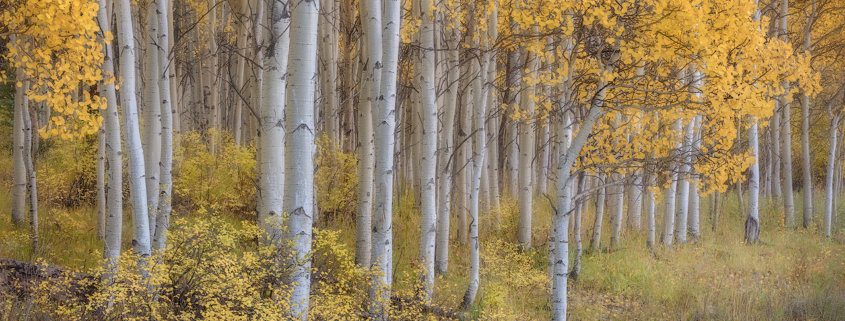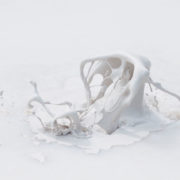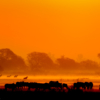Six simple tools for better intimate landscape photography
There is a sub-genre of nature photography that deserves some attention. Unlike the Grand Landscape, which dazzles us with flashy colors and dramatic near-far views, the intimate landscape photography seduces us with subtlety and quiet invitation. It entices us to explore a deeper experience in the photograph. In plain terms, Intimate Landscape photos are smaller scenes extracted from the larger view. They may be comprised of an entire side of a mountain, or a small, interesting detail found in a pattern of leaves. Here are some tips to help you find your way into their world.
Shady conditions are ideal for intimate landscape photos, such as this one. Harsh light can make it difficult to impossible to retain fine detail in the highlights and shadows.
1. Seek shade.
Low contrast light may not seem terribly thrilling for a landscape photograph, but it is perfect for the intimate landscape photography. Intimates don’t rely upon flashy sunsets or low angle light. There are plenty of subjects that shine in shady conditions, such as trees, flowers, and waterfalls.
Intimate landscapes are extracted from a larger scene. Sometimes the scene is at your feet, like these beautiful, frost-covered Autumn leaves I found one morning just as the sun crested the hill.
2. Get up close and personal.
Zero in on the most interesting part of a scene with a telephoto lens. A fixed telephoto or a telephoto zoom lens lets you frame the scene tightly, eliminating distracting elements, and compressing the scene. If you don’t have a telephoto lens, you can use a mid-range lens, then “zoom with your feet” to get closer to your subject.
Including sky in the landscape photo titled “Spirit of Pohono” above would have been distracting. The light and mist of the waterfall was the story to tell. A 70mm focal length was all that was need to frame this scene. A shutter speed of 1/10 sec. at ƒ/16 ensured everything would be in focus.
3. Eliminate the sky from your composition.
Dramatic skies are an important part of the traditional landscape composition, but in the context of an intimate landscape photography, a bright sky can be distracting. The sky is usually the brightest part of a composition and will draw the eye away from your subject. By leaving it out, you will have better control of how you want the viewer’s eye to move through the frame.
4. Start wide, go narrow.
As you approach that big, beautiful landscape, you may be tempted to pick your wide-angle lens out of the bag. Go ahead and do that, but don’t stop there. Start zeroing in on more interesting compositions within the larger frame. One way to pick out more intimate compositions is to expose an image using a wide-angle lens, then use the magnify button on the back of your camera to scroll around the image you just made to see if there are any smaller, compelling compositions within the frame. If you have a frame card — a small piece of mat board cut with an opening proportional to your sensor — you can use it to frame up a smaller scene before you even get the camera out of the bag.

“Mouth of the Klamath” — The curvy lines and fleshy colors in the sand spit give this composition a gentle, sensual feel. A long, 30-second exposure reduced the surf to smooth, light, soft lines, contrasted against the dark, rocky shore.
5. Speaking of composition…
Intimate Landscapes cannot rely upon dazzling sunrises to catch the attention of the viewer. So, composition is especially paramount in constructing an Intimate. Think beyond the “rule of thirds”, which is so common in traditional landscape photography. Pay close attention to the way lines and shapes move the eye through the composition and how those lines may evoke emotional response. For example, horizontal lines create a sense of serenity because objects parallel to the Earth are at rest. Vertical lines create a sense of power, strength, and stature. Diagonal lines create movement and energy. Curvy lines suggest comfort and ease. And symmetry conveys a sense of stability.

“Jewels of the Merced”, Yosemite National Park — I spotted these patterns in the river bottom as I was exploring around Yosemite Valley. In order to freeze the movement of the ripples, I selected a fast shutter speed. And, I wanted everything to be in focus front to back, so I needed to use an aperture of ƒ/16 or smaller. Even though it was a bright, sunny day, a high ISO selection was required in order to balance the exposure. Canon EOS R, Canon 70-200mm ƒ/2.8 L lens, ISO 5000, 200 mm, ƒ/16, 1/250 sec.
6. Hone your eye to recognize textures, lines, colors, value, and shapes in nature
A photograph is constrained by two dimensions. Therefore, in order to create depth and movement through your composition, there are a few other tools in the box you can use. Texture, lines, colors, tonal value, and shapes are all devices at the artist’s disposal to make a compelling image. Look for them in nature. When you develop your eye for the building blocks of composition, you will begin to see them everywhere — texture in grasses; contrast of colors in the surface of water; sticks as lines; rocks as shapes. Use nature’s pallet to build your composition. Train your eye to see in two dimensions.
These few quick tips are only a start to help you begin to see differently. To read more about creativity and learning to see in a new way, you can read some of my other articles on the subject of creativity here. If you have some thoughts to share on how you have developed your own eye, I’d love to hear from you in the comments below.















Thanks for the inspiration! I am taking a photo class in May with the Yosemite Conservancy and intend to get shots that no one else may have!
You have the most beautiful shots of Yosemite. Thanks for the inspiration. I’m taking a class with the Yosemite Conservancy in May and intend to get different shots than everyone else!